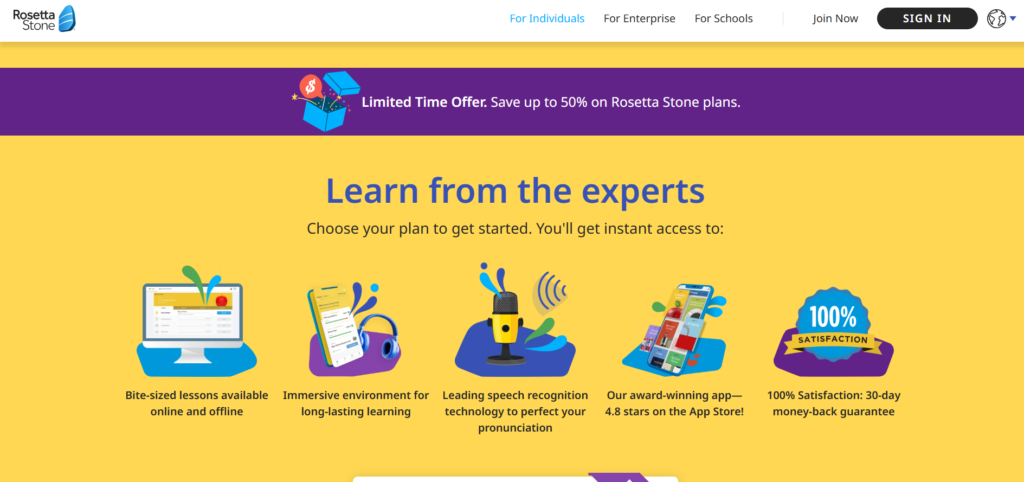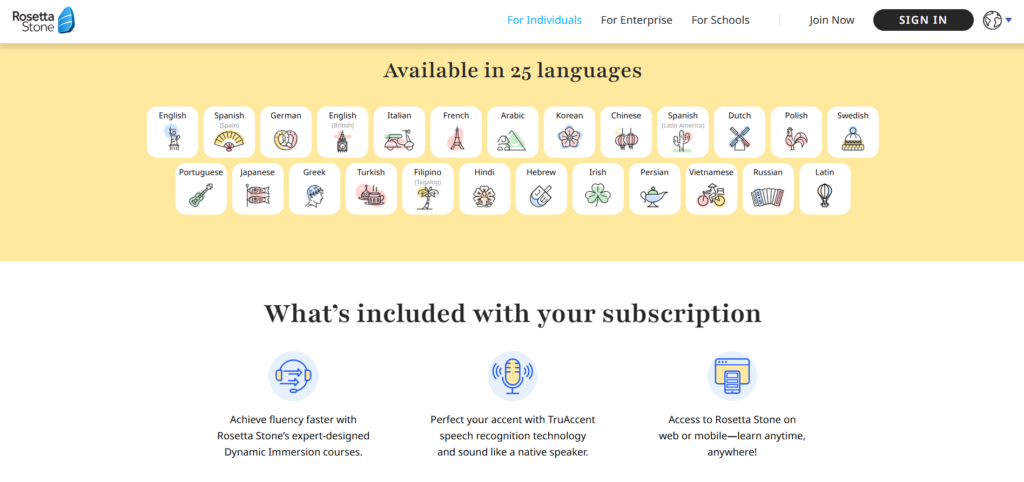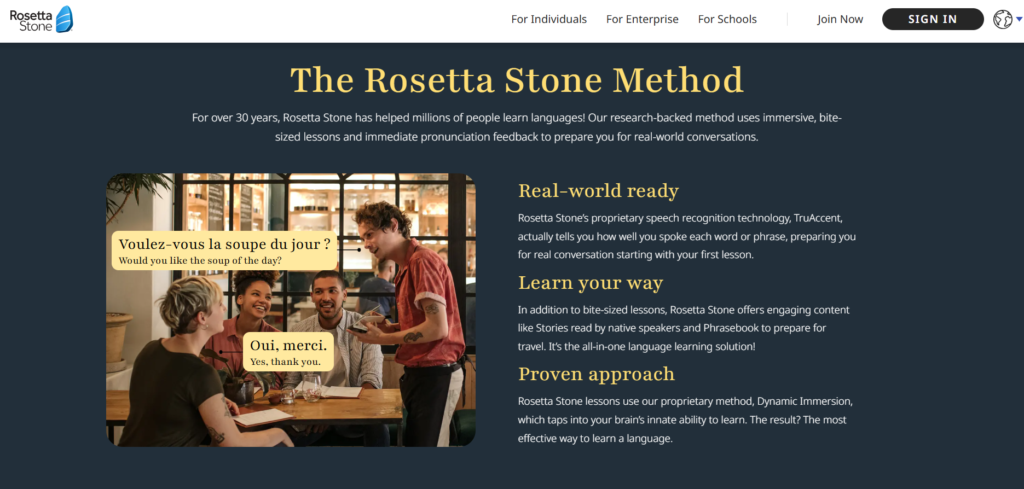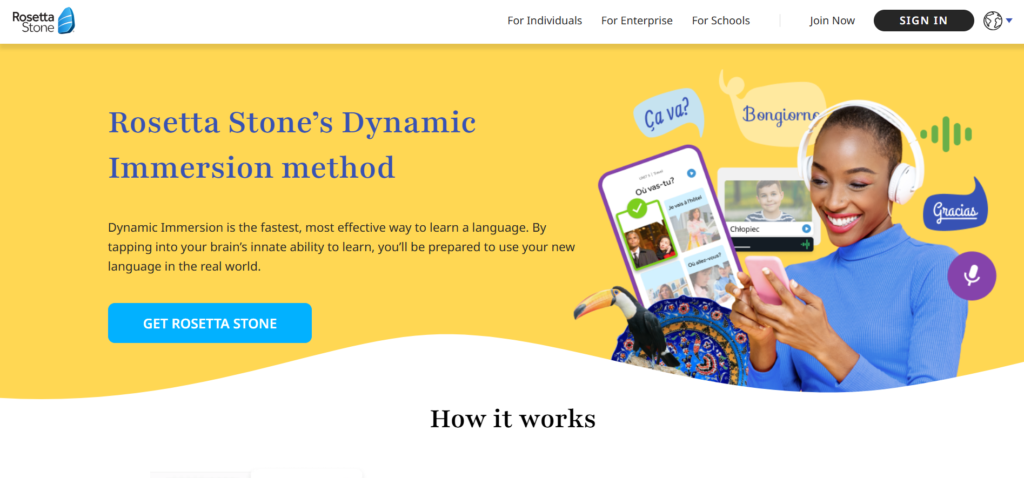Learning a new language is both an exciting and challenging adventure, and in today’s world, there’s no shortage of tools to help you on this journey. Among these tools, Rosetta Stone has stood the test of time.
It’s a popular language-learning platform that’s been helping people learn languages for decades. In this review, we will explore the platform in detail, look at how it works, its features, pros and cons, pricing, and much more. Let’s dive into it!
What is Rosetta Stone?

Rosetta Stone is a language learning platform that uses a unique approach to teach languages. Founded in 1992, it’s one of the oldest and most recognized names in the world of language education. The platform’s signature approach is called Dynamic Immersion, which is designed to mimic the natural way we learn our first language – through exposure and association with images, sounds, and context rather than through direct translation. It focuses on helping learners think directly in the target language from the very beginning.
The program is available on multiple platforms, including computers, tablets, and smartphones, making it easy for users to practice whenever and wherever they want.
What Languages Does Rosetta Stone Offer?
Rosetta Stone supports 25 different languages, which is a solid variety for those looking to pick up a new language. Some of the most popular languages include:

- Spanish (Latin American and Spain)
- French
- German
- Italian
- Chinese (Mandarin)
- Japanese
- Korean
- Russian
- Portuguese (Brazilian)
- Arabic
- Hindi
- Tagalog
- Vietnamese
- Greek
- Swedish
- Polish
- Filipino
Whether you’re looking to learn a widely spoken language or something more niche, there’s a good chance Rosetta Stone has you covered. The number of languages they offer makes the platform versatile, appealing to both casual learners and those seeking to master a language for professional purposes.
The Learning Method: Dynamic Immersion

One of the key selling points of Rosetta Stone is its Dynamic Immersion method. This approach is based on the idea that language is best learned when it’s introduced in a context that’s meaningful, rather than through explicit grammar lessons or direct translations.
The goal is to help learners start thinking in the target language by associating words with images and sounds rather than translating them into their native language.
The method involves lessons that use a combination of visuals, spoken audio, and written text. For example, you might be shown a picture of a dog with the word “perro” (Spanish for “dog”) beneath it.
The idea is that you make the connection between the word and the image, rather than thinking of the translation first. This helps develop fluency in the language, as you’re learning vocabulary, sentence structure, and grammar without the need for constant translation.
Features of Rosetta Stone

TruAccent® Speech Recognition
A standout feature of Rosetta Stone is its speech recognition technology called TruAccent®. This tool listens to your pronunciation as you speak and provides real-time feedback on how closely your pronunciation matches that of a native speaker. It’s designed to help learners improve their accents and pronunciation accuracy.
This is particularly useful when learning languages with complicated pronunciations, such as Mandarin Chinese or Arabic. TruAccent® helps learners sound more natural and confident in their speaking abilities.
Bite-Sized Lessons
Rosetta Stone uses short, focused lessons that make it easier to fit language learning into a busy schedule. Each lesson is designed to teach one specific language skill, whether it’s vocabulary, pronunciation, grammar, or listening comprehension.
These bite-sized lessons are great for learners who want to practice a little every day without feeling overwhelmed. It’s ideal for those who may only have 15 to 30 minutes a day to dedicate to their language learning.
Comprehensive Learning Approach
Rosetta Stone doesn’t just focus on vocabulary. The platform covers a full range of language skills, including speaking, listening, reading, and writing. This helps ensure that learners develop a well-rounded understanding of the language.
Over time, you’ll be exposed to a wide variety of sentence structures, tenses, and grammar rules, which helps reinforce your understanding.
No Translation
Unlike other platforms that often provide translations for each word or phrase, Rosetta Stone avoids using your native language for translations. Instead, it immerses you in the target language completely.
This may seem challenging at first, but it helps encourage learners to think directly in the language. The idea is to bypass translation and move toward thinking in the new language, much like how children learn their first language.
Accessibility
One of the advantages of Rosetta Stone is its accessibility. The platform is available across a range of devices, including:
- Windows and macOS computers
- iOS and Android devices (smartphones and tablets)
- Xbox One (through the Discover Languages app)
This makes it incredibly convenient to use Rosetta Stone no matter where you are. Whether you’re at home, commuting, or traveling, you can easily continue your language lessons. The flexibility of learning on multiple devices makes it a great option for busy individuals who want to learn on the go.
Pricing and Subscription Options
Rosetta Stone offers several subscription plans to suit different needs and budgets. These include:

- 3-Month Plan: Typically priced at around $59.85, this plan gives you access to a single language for three months.
- 12-Month Plan: Priced around $239.40, this plan grants you a full year of access to your chosen language.
- Lifetime Plan: This plan costs around $179 and gives you lifetime access to all 25 languages offered by Rosetta Stone. This is ideal for learners who want to explore multiple languages or are committed to long-term language learning.
There’s also a 3-day free trial available for new users, which allows you to explore the platform before making any commitments. If you’re not sure whether Rosetta Stone is the right fit for you, the free trial gives you a risk-free opportunity to test the service.
Pros of Rosetta Stone
Immersive Learning:
The Dynamic Immersion method helps you learn in a natural and intuitive way. Instead of relying on translations, you’re learning to think directly in the target language, which can lead to faster and more efficient learning.
Comprehensive Approach:
Rosetta Stone offers a well-rounded language education, covering speaking, reading, listening, and writing. This ensures that you’re not just memorizing vocabulary but actually learning how to use the language in a variety of contexts.
Speech Recognition:
The TruAccent® feature is a game-changer for pronunciation. It gives learners the chance to improve their accent and sound more like a native speaker.
User-Friendly Interface:
The interface is easy to navigate, making it accessible even for beginners who may not be tech-savvy.
Flexibility:
The ability to use Rosetta Stone across different devices makes it easy to learn on the go. Whether you prefer using your computer, tablet, or phone, you can access your lessons anytime.
Cons of Rosetta Stone
Lack of Cultural Context:
Some learners have pointed out that Rosetta Stone doesn’t provide much in the way of cultural context, which can be important for understanding the nuances of a language. While the platform teaches you the basics of the language, it doesn’t delve deeply into the cultural aspects, such as slang or idiomatic expressions.
Limited Advanced Content:
While the platform is fantastic for beginners and intermediate learners, advanced learners may find the content lacking in complexity. After reaching an intermediate level, you might need to look for additional resources to deepen your understanding of the language.
No Focus on Grammar Rules:
Although the lessons teach you how to use the language, they don’t explicitly explain grammar rules. Some learners may find this difficult, especially if they’re used to traditional language learning methods that focus heavily on grammar.
Final Thoughts
Rosetta Stone remains one of the most popular and effective language learning platforms available. Its immersive approach, combined with cutting-edge speech recognition technology, makes it an appealing option for anyone looking to learn a new language.
While it’s best suited for beginners and intermediate learners, the platform’s strengths in vocabulary, pronunciation, and speaking skills make it a great choice for those who are serious about language learning.
While it may not be perfect for advanced learners or those looking for a deep dive into grammar and cultural nuances, Rosetta Stone’s overall effectiveness and user-friendly design make it a top choice for language enthusiasts.
Whether you want to pick up Spanish, French, or Mandarin, Rosetta Stone offers a convenient and effective way to achieve your language learning goals.
FAQs About Rosetta Stone
Is Rosetta Stone good for beginners?
Yes, Rosetta Stone is perfect for beginners. It provides a solid foundation in the language, helping you build your vocabulary and understanding of basic sentence structure.
Can I learn multiple languages at once?
Yes, with the lifetime subscription, you can learn multiple languages simultaneously, which is great if you’re interested in exploring different languages or need to learn one for travel and another for business.
Does Rosetta Stone have a free trial?
Yes, Rosetta Stone offers a 3-day free trial. This allows you to explore the platform and see if it’s a good fit for your language learning needs before making a commitment.
Is Rosetta Stone effective for pronunciation?
Yes, the TruAccent® speech recognition technology is one of the standout features of Rosetta Stone. It helps learners improve their pronunciation by providing instant feedback.
Is Rosetta Stone suitable for advanced learners?
While Rosetta Stone is excellent for beginners and intermediate learners, advanced learners may find that the platform lacks more complex grammar lessons and advanced content. You may need additional resources for further language mastery.



